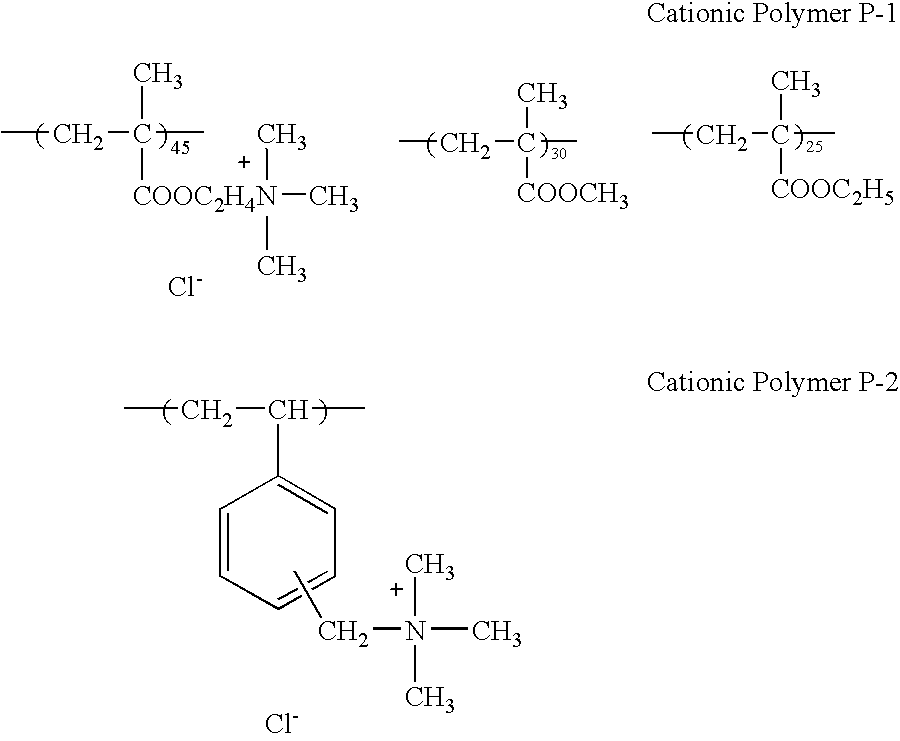Ink-jet recording sheet
a technology of inkjet and recording sheet, which is applied in the direction of duplicating/marking methods, thermography, coatings, etc., can solve the problems of oxidizing gases such as ozone, which are present in ambient air, and the storage stability is not sufficient, so as to achieve excellent image clarity, excellent ink absorbability, and no deterioration of the quality of the layer surface
- Summary
- Abstract
- Description
- Claims
- Application Information
AI Technical Summary
Benefits of technology
Problems solved by technology
Method used
Image
Examples
example 1
>
[0091] Oil Dispersions A-1-A-14 were prepared in such a manner that 400 g of polybutadienes (B-1000, manufactured by Nippon Soda Co., Ltd.) was mixed with each of the surface active agents and hydrophilic polymers described in Table 1, the resulting mixture was dispersed employing a high pressure homogenizer, and the total volume was adjusted to 1 L (40% effective component of the oil-soluble compound) by adding pure water.
[0092] Each of the resulting dispersions was sealed in a glass tube and left standing at 40° C. for 24 hours. Thereafter, the dispersion state was visually observed and the stability of each dispersion was evaluated.
[0093] Each abbreviation described in Table 1 is detailed below. [0094] *1: Emulgen 105 (HLB 9.7, manufactured by Kao Corp.) [0095] *2: Emulgen 103 (HLB 8.1, manufactured by Kao Corp.) [0096] *3: Emulgen 306 (HLB 9.4, manufactured by Kao Corp.) [0097] *4: Emulgen 404 (HLB 8.8, manufactured by Kao Corp.) [0098] *5: Emulgen 408 (HLB 10.0, manufactured...
example 2
>
(Preparation of Silica Dispersion D-1)
[0107] While stirring at 3,000 rpm at room temperature, 400 L of Silica Dispersion B-1 (exhibiting a pH of 2.5 and containing 0.5% ethanol) containing 25% uniformly dispersed vapor phase method silica (Aerosil 300, manufacture by Nippon Aerosil Co., Ltd.) of an average diameter of the primary particle of 0.007 μm was added to 110 L of Aqueous Solution C-1 (exhibiting a pH of 2.5 and containing 2 g of Defoamer SN-381, manufactured by Sun Nobco Ltd.) containing 12% Cationic Polymer P-1, 10% n-propanol, and 2% ethanol. Subsequently, while stirring, 54 L of Aqueous Mixture Solution A-1 of boric acid and borax at a ratio of 1:1 (having a concentration of 3% for each) was gradually added.
[0108] Subsequently, the resulting mixture was dispersed at 3 kN / cm2, employing a high pressure homogenizer manufactured by Sanwa Industry Co., Ltd., and the total volume was adjusted to 630 L by adding pure water, whereby nearly transparent Silica Dispersion D-1 ...
PUM
| Property | Measurement | Unit |
|---|---|---|
| boiling point | aaaaa | aaaaa |
| boiling point | aaaaa | aaaaa |
| particle diameter | aaaaa | aaaaa |
Abstract
Description
Claims
Application Information
 Login to View More
Login to View More - R&D
- Intellectual Property
- Life Sciences
- Materials
- Tech Scout
- Unparalleled Data Quality
- Higher Quality Content
- 60% Fewer Hallucinations
Browse by: Latest US Patents, China's latest patents, Technical Efficacy Thesaurus, Application Domain, Technology Topic, Popular Technical Reports.
© 2025 PatSnap. All rights reserved.Legal|Privacy policy|Modern Slavery Act Transparency Statement|Sitemap|About US| Contact US: help@patsnap.com

